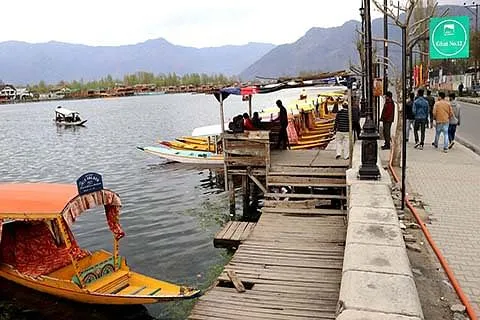Dal lake “a jewel in the crown of Kashmir” and “the lake of flowers”, is one of the most popular tourist spots of Kashmir valley.
It has a very rich history and is a part of the civilization from ancient times. Kalhana, a 12th century poet, writes about it in the Rajtarangni, the legendary and historical chronicle of the north-western Indian subcontinent “as a place where the sun shines mildly being the place created by Kashyapa Rishi”.
Kashyapa the legendary sage created the valley of Kashmir which was a vast high-altitude lake by draining it. The word Kashmir was derived from the ancient Sanskrit language and was referred to as Kasmira. There are many other versions of the origin of this name but most believe it has its origin as a land desiccated from water.
Another version originating even before Rajtarangini describes Dal Lake as a plain desert to which King Pravarsen brought the river Jhelum from the foot hills of Kohimaran also known as Hari Parbat.
After a great deal of time, the river rose in floods and as a result of the deluge became a lake. Sultan Sikandar of the Shahmiri dynasty constructed a very strong bund upon it from Nayiyar to Nishat Bagh during his rule from 1389 to 1413.
Another bund from Khwajayarbal to Aishabad (presently Ashai-Bagh) on Sodrakhun Lake (Nageen basin), was constructed by Saif Khan, Governor of Kashmir who ruled the valley from 1647 to 1671 during the reign of Aurangzeb.
The lake experiences, temperatures in the range of 1 to minus 11 °C during winter and 12 to 30 °C during the summers. The lake freezes when temperatures drop to about −11 °C during severe winters.
During the Dogra rule, Srinagar became their capital. Attracted by the cool climate of the Kashmir valley, amidst the back drop of the majestic snow-covered Himalayan ranges, Maharaja Pratap Singh made his palace overlooking the Dal Lake in 1910 and named it Gulab Bhawan.
It served as the Palace of the ruling family in Kashmir. During the Dogra rule there were restrictions of building of houses around the Dal.
The British however circumvented it and brought in the houseboats, which still are the beauties in the lake visible from the picturesque Boulevard Road. In the recent years lot more houses have come around in that area behind the front-line houses in the form of several colonies.
Dal lake is also known for its floating gardens, labelled the ‘Raad’ in the Kashmiri language are a special feature of the lake.
They basically constitute of matted vegetation and earth, but are floating. These are detached from the bottom of the lake and drawn to a suitable place (generally to the north west of the houseboats’ location) and anchored. Given its rich nutrient properties nutrient properties, tomatoes, cucumbers and melons are grown with very good results.
The major environmental problem facing the lake is excessive plant and algae growth, which require remedial measures to combat it. Alarmingly, the size of the lake has shrunk from its original area of 22 square kilometres to the present area of 18 square kilometres and there is a concerning rate of sediment deposition due to catchment area degradation.
The water quality has also deteriorated due to intense pollution caused by the untreated sewage and solid waste that is fed into the lake from the peripheral areas and from the settlements and houseboats.
The famous Mughal gardens around the lake have been built during 16th –17th century and their number was about five hundred but only a few of these, which we see today have survived.







